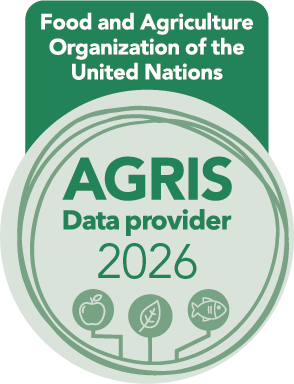Diversity of Plant Species on Farms in the Municipality of Camagüey
DOI:
https://doi.org/10.5281/zenodo.7948628Keywords:
agrobiodiversity, agroecosystem, diversity of ecosystems, diversity of speciesAbstract
Context: The preservation of biodiversity integrated into agricultural practices may bring about enormous social, economic, and ecological benefits; Hence, the practices that conserve and have a sustainable use, increasing biodiversity, are necessary for farming systems to ensure food production, life quality, and the health of ecosystems.
Aim: To conduct a qualitative and quantitative evaluation of plant species diversity as an element of agroecosystem functioning.
Methods: The species found on farm fields (0.24 hectares) are shown. Accordingly, the farm areas were divided into 6 transects (80 m x 5 m each), in 16 5 x 5 m plots. The Alpha diversity indexes were calculated (the Margalef diversity index, the Pielou uniformity index, the Shannon-Wiener index), and Beta (the Jaccard index); the agroecosystem agrobiodiversity index was included as well.
Results: The Alpha diversity indexes was inclined to average-high diversity values, and low dominance; whereas the Jaccard index indicated the existence of average similar farms as to the herbaceous-arboreal species, and floristically-differing arboreal species. The study demonstrated unsustainable management of agro diversity.
Conclusions: The farms differed floristically regarding the arboreal plants, and were average different for the herbaceous plants, whereas the Agricultural Diversity Index evidenced the implementation of unsustainable management practices to agroecosystems, which did not include the application of agroecological principles, and management aiming to increase income rather than the protection of the ecosystem. Consequently, the production and management model implemented is ecologically unsustainable.
Downloads
References
Alonso-Torrens, Y., Hernández Martínez, F. R., Barrero-Medel, H., López-Ibarra, G., Madanes, N., & Prieto-Méndez, J. (2016). Estructura y composición de la vegetación de pinares de Alturas de Pizarras en la Empresa Agroforestal Minas, Cuba. Madera y bosques, 22(3), 75-86, doi: https://doi.org/10.21829/myb.2016.2231458
Altamirano Hernández, I. J., Amador López, M. F., & Montalbán Castellón, O. (2017). Complejidad y sostenibilidad de dos agroecosistemas con cacao, Siuna 2017. Revista Universitaria del Caribe, 19 (2), 103-112. Retrieved on December 3, 2019, from: https://revistas.uraccan.edu.ni/index.php/Caribe/article/view/493/501
Altieri, M. A. (1992). El rol ecológico de la biodiversidad en agroecosistemas. Agroecologia y Desarrollo. Revista de CLADES, (Número Especial 4), 2-11. Retrieved on December 3, 2019, from: https://agroabona.files.wordpress.com/2011/01/el-rol-ecologico-de-la-biodiversidad-en-agroecosistemas.pdf
Baskin, J. M. & Baskin, C. C. (1989). Physiology of dormancy and germination in relation to seed bank ecology. In M. A., Leck, V. T. Parker & R. L. Simpson (Eds.), Ecology of Soil Seed Banks (Pt. 2, cap. 4, pp 53-66). Academic Press, doi: https://doi.org/10.1016/B978-0-12-440405-2.X5001-5
Céspedes Cansino, J., Jiménez Rodríguez, M., & Estévez Domínguez, M. (2019). Diversidad de especies vegetales en seis fincas del municipio Minas, Camagüey. Agrisost, 25(1), 1-10. Retrieved on January 20, 2020, from: https://revistas.reduc.edu.cu/index.php/agrisost/article/view/e2724
Comisión Nacional para el Conocimiento y Uso de la Biodiversidad. (2014). La Biodiversidad en Chihuahua: Estudio de Estado. México: Autor. Retrieved on December 23, 2019, from: https://bioteca.biodiversidad.gob.mx/janium/Documentos/7397.pdf
Cortés Gutiérrez, L. & Matiz Guerra, L. (2015) Almanaque agroecológico Arrayanes-Curubital: Recuerdos vivos: Agua de páramo, fuente de vida. Bogotá: El Jardín.
Díaz, J. P., Rodríguez-Sperat, R., & Paz, R. (2018). Valoración de una experiencia de intervención con tecnologías socialmente apropiadas en Santiago del Estero (Argentina). Corpoica. Ciencia y Tecnología Agropecuaria, 19(1), 61-78, doi: https://doi.org/10.21930/rcta.vol19_num1_art:531
Galluzzi, G., Eyzaguirre, P., & Negri, V. (2010). Home gardens: neglected hotspots of agrobiodiversity and cultural diversity. Biodiversity and conservation, 19, 3635-3654, doi: https://doi.org/10.1007/s10531-010-9919-5
González, Y., Leyva, A., Pino, O., Mercadet, A., Antoniolli, Z. I., Arébalo, R. A., … Gómez,, Y. (2018). El funcionamiento de un agroecosistema premontañoso y su orientación prospectiva hacia la sostenibilidad: rol de la agrobiodiversidad Cultivos Tropicales, 39(1), 31-24. Retrieved on September 3, 2019, from: http://scielo.sld.cu/pdf/ctr/v39n1/ctr03118.pdf
Leyva, A., & Lores, A. (2012). Nuevos índices para evaluar la agrobiodiversidad Agroecología, 7(1), 109-115. Retrieved on September 5, 2019, from: https://revistas.um.es/agroecologia/article/view/171061
Moreno, C. E. (2001). Métodos para medir la biodiversidad. (Vol. 1). Zaragoza, España: M&T Manuales y tesis Sea. Retrieved on December 7, 2019, from: https://www.researchgate.net/publication/304346666_Metodos_para_medir_la_biodiversidad
Organización de Naciones Unidas para la Alimentación y la Agricultura (n.d.). La biodiversidad para el mantenimiento de los agroecosistemas. Retrieved on December 5, 2019, from: http://www.fao.org/3/i0112s/i0112s02.pdf
Organización de Naciones Unidas para la Alimentación y la Agricultura. (2018). Mensajes principales En Agricultura sostenible y biodiversidad: un vínculo indisociable. (p. 6). Roma, Italia: FAO. Retrieved on December 20, 2019, from: http://www.fao.org/3/a-i6602s.pdf
Ortiz Pérez, R., Angarica, L., & Guevara-Hernández F. (2014). Beneficios obtenidos en fincas participantes en el “Programa de Innovación Agropecuaria Local (PIAL)” en Cuba. Análisis costo/beneficio de la intervención. Cultivos Tropicales, 35 (3), 107-112. Retrieved on November 15, 2019, from: http://scielo.sld.cu/pdf/ctr/v35n3/ctr13314.pdf
Stupino, S. A., Ferreira, A. C., Frangi, J., & Sarandón S. J. (2007). Agrobiodiversidad vegetal en sistemas hortícolas orgánicos y convencionales (La Plata Argentina) Revista Brasileña de Agroecología. Resumos do II Congresso Brasileiro de Agroecologia, 2(1), 339-342. Retrieved on February 15, 2019, from: http://revistas.aba-agroecologia.org.br/index.php/rbagroecologia/article/view/6306/4613
Torres La Rosa, M. (5 de septiembre de 2019). Aplican en Camagüey tecnologías para el desarrollo de fincas familiares. Adelante, p. 2. Retrieved on December 17, 2019, from: http://www.radionuevitas.icrt.cu/camagueey/1641-aplican-en-camagueey-tecnologias-para-el-desarrollo-de-fincas-familiares.html
Vargas Batis, B., Candó González, L., Pupo Blanco, Y., Ramírez Sosa, M., Escobar Perea, Y., Rizo Mustelier, M., … Vuelta Lorenzo, D. (2016). Diversidad de especies vegetales en fincas de la agricultura suburbana en Santiago de Cuba. Agrisost, 22 (2), 1-23. Retrieved on December 10, 2019, from: https://revistas.reduc.edu.cu/index.php/agrisost/article/view/296
Vargas Batis, B., Candó González, L., Ramírez Sosa, M., Rizo Mustelier, M., Pupo Blanco, Y., González Pozo, L., … Molina Lores, L. (2017). Diversidad de plantas objeto de cultivo en cuatro fincas de la agricultura suburbana de Santiago de Cuba. Agrisost, 23 (3), 90-110. Retrieved on January 10, 2020, from: https://revistas.reduc.edu.cu/index.php/agrisost/article/view/2114
Downloads
Published
Issue
Section
License
Copyright (c) 2020 Yudelkis González Portelles, José Luis Céspedes Cansino, Concepción de la Torre Rodríguez

This work is licensed under a Creative Commons Attribution-NonCommercial-NoDerivatives 4.0 International License.
You are free to:
- Share — copy and redistribute the material in any medium or format
- The licensor cannot revoke these freedoms as long as you follow the license terms.
Under the following terms:
- Attribution — You must give appropriate credit , provide a link to the license, and indicate if changes were made . You may do so in any reasonable manner, but not in any way that suggests the licensor endorses you or your use.
- NonCommercial — You may not use the material for commercial purposes .
- NoDerivatives — If you remix, transform, or build upon the material, you may not distribute the modified material.
- No additional restrictions — You may not apply legal terms or technological measures that legally restrict others from doing anything the license permits.






